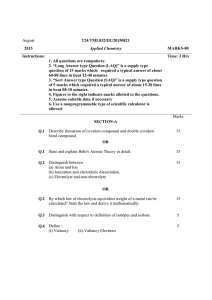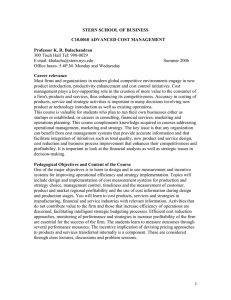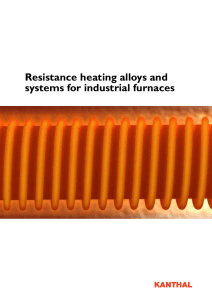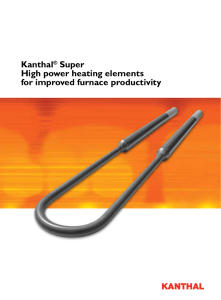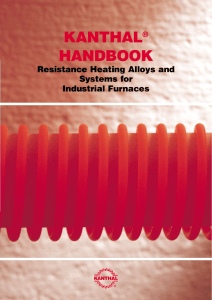Resistance Heating Alloys and Systems for Industrial
advertisement
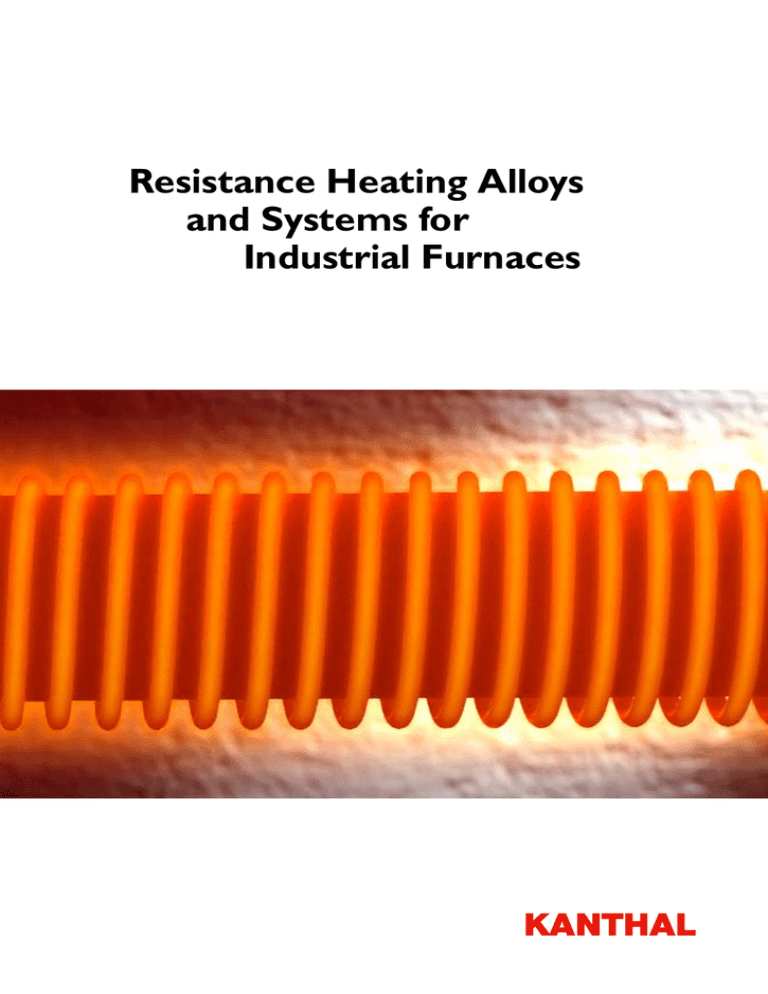
Resistance Heating Alloys and Systems for Industrial Furnaces Catalogue 1-A-5B-3 UK 11-08-3000 © Kanthal AB. May be reproduced only with proper acknowledgement of the source. Disclaimer: The information contained in this document is for illustrative purposes only. The data and examples are only general recommendations, and not a warranty or a guarantee that such data will function in individual/specific cases. The purchaser of a Kanthal product has the responsibility to control the applicability of Kanthal’s products in a specific application before using them. ® KANTHAL, NIKROTHAL, TUBOTHAL and ECOTHAL are registered trademarks of Kanthal Group companies in Sweden and other countries Kanthal – a Member of the Sandvik Group The Sandvik Group is a global high technology enterprise with 47,000 employees and annual sales of approximately SEK 86 billion. Sandvik spends about 4 percent of is turnover on research and development. As a member of the Sandvik Group, Kanthal has full access to world-class competence within materials and process technology, as well as Sandvik’s R&D-center in Sweden, which is one of the most distinguished in the world. Through Sandvik’s global sales organization Kanthal is represented in 130 countries. 2 Resistance Heating Alloys and Systems for Industrial Furnaces Contents Page Metallic Heating Elements from Kanthal................................................................................................................................. 4 KANTHAL® or NIKROTHAL®?.................................................................................................................................................. 5 KANTHAL APMTM Heating Material ...................................................................................................................................... 6 Physical and Mechanical Properties........................................................................................................................................... 7 Furnace Wall Loading ...................................................................................................................................................................... 8 Element Surface Load........................................................................................................................................................................ 9 Operating Life and Maximum Permissible Temperature ...........................................................................................10 Key Data for Kanthal Elements...................................................................................................................................................12 Kanthal TUBOTHAL® – the Most Powerful Metallic Element System ..............................................................14 KANTHAL PM Material.................................................................................................................................................................16 Gas Fired Systems..............................................................................................................................................................................18 KANTHAL APM Standard Product Range.........................................................................................................................20 Tables KANTHAL A-1 and APM.............................................................................................................................................23 KANTHAL AF.....................................................................................................................................................................24 KANTHAL D.......................................................................................................................................................................25 NIKROTHAL 80.................................................................................................................................................................26 NIKROTHAL 70.................................................................................................................................................................27 Terminals.................................................................................................................................................................................28 3 Metallic Heating Elements from Kanthal This booklet contains technical data for our resistance heating alloys KANTHAL and NIKROTHAL. We also include some instructions for the calculation and design of heating elements for industrial furnaces as well as examples of support systems and insulation. Out of the KANTHAL PM (powder metallurgical/production route) group tubes are only shortly described, detailed information is found in KANTHAL PM tubes handbook. The latest product- and application information is found on www.kanthal.com. We can assist you: • in choosing suitable element material, element type, support system and insulation, • by supplying complete heating elements ready for installation, • in upgrading both electrical and gas heated furnaces by delivering technical solutions based on latest material technology rendering maximum productivity and economy • to replace radiant tubes with KANTHAL APM tubes in both gas- and electrically heated furnaces and to supply complete recuperative burner systems (ECOTHAL® – SER). Our modern workshops have developed considerable experience in manufacturing heating elements and can manufacture to any specifications. Our delivery times are short and our service objectives are high. KANTHAL® or NIKROTHAL® ? There are two main types of electric resistance alloys. Nickel-chromium (e.g. 80 Ni, 20 Cr) called NIKROTHAL was developed around the beginning of the 20th century and was soon used as heating element material in industrial furnaces as well as in electric household appliances. In the thirties Kanthal introduced a new resistance heating alloy (called KANTHAL) based on ironchromium-aluminium with a longer life and a higher maximum operating temperature than nickel-chromium. Kanthal manufactures both types of alloys under the names NIKROTHAL (nickel-chromium) and KANTHAL (iron-chromium-aluminium). The two main types of alloys have their own specific properties, with advantages and disadvantages, and are supplied in many different grades and forms. In general KANTHAL type alloy is superior to NIKRO­THAL in respect of performance and life and is therefore nowadays a standard material choice when it comes to metallic heating elements for industrial furnaces. The NIKROTHAL alloy may have special advantages if you need a heating element having very good mechanical properties in the hot state. KANTHAL Element Data Weight saving based on same wire diameter: [kg] 44.4 – 29.6 = 33 % 44.4 The most important advantages with KANTHAL type alloy are: • H igher maximum temperature of 1425°C compared to 1250°C • Longer life (2–4 times) • Higher surface load • Higher resistivity • Lower density • N o spalling oxide, which may contaminate the goods and the furnace and also cause short circuit or failure of elements and gas burners. APM has, however, creep strength at elevated temperatures in the same level as NIKROTHAL. For the furnace user, using KANTHAL results in less amount of material at a lower price and also – a longer life. Table 1 shows an example of weight saving – and lower cost – obtained by using KANTHAL instead of nickel-chromium alloys. This lower element weight will also result in considerable cost savings regarding support system, because fewer suspension hooks are necessary. NIKROTHAL KANTHAL Furnace temperature [°C] 1000 1000 Element temperature [°C] 1068 1106 Hot resistance [Rw] 3.61 3.61 Temperature factor [Ct] 1.05 1.06 Cold resistance [R20] 3.44 3.41 Wire diameter [mm] 5.5 5.5 Surface load [W/cm ] 3.09 3.98 Wire length [m] 3 elements 224.9 174.6 Wire weight [kg] 3 elements 44.4 29.6 2 Table 1 A 120 kW furnace equipped with R.O.B. elements. 3 elements of 40 kW each, 380 V. 5 KANTHAL APMTM Heating Material KANTHAL APM is a resistance material which can be used to improve the performance at high temperatures, where conventional metallic elements are getting problems like bunching, creeping, oxide spallation and to open up new applications where metallic elements are not used today. The Great Advantages of KANTHAL APM are: Improved hot strength, giving: • much better form stability of the heating element • less need for element support • low resistance change (ageing) • longer element life Excellent oxide, giving: • good protection in most atmospheres, especially corrosive atmospheres • no scaling and impurities • a longer element life Creep Rupture Strength for Industrial Wire 4 mm Time [h] 100 1000 10000 Time [h] 100 1000 10000 Time [h] 100 1000 Temp. 1000°C [MPa] 5.0 3.1 2.1 Temp. 1200°C [MPa] 3.3 1.6 0.6 Temp. 1400°C [MPa] 1.3 0.5 Comparison between KANTHAL APM (top) and conventional FeCrAl after 1250 h at max 1225°C element temperature. Elongation [%] 15 FeCrAl 10 5 APM 0 - 5 Time [h] 0 100 200 300 400 500 600 Fig. 1 Elongation at 1300°C element temperature. Sagging [mm] 1400°C FeCrAl 30 1300°C FeCrAl 20 10 APM 1400°C 0 APM 1300°C 0 50 100 Time [h] 150 Fig. 2 Sagging test diam. 9.5 mm, 1300°C and 1400°C, 300 mm between supports. 6 Physical and Mechanical Properties KANTHAL and NIKROTHAL alloys are generally available in wire, ribbon or strip form. Physical and mechanical properties of the alloys are listed in Table 2. Ct factor see page 23 and following. KANTHAL APM KANTHAL A-1 KANTHAL AF 1425 1400 1300 1300 1200 1250 1150 1100 [%] Cr 22 22 22 22 20 30 15 20 Al 5.8 5.8 5.3 4.8 – – – – Fe Balance Balance Balance Balance – 5 % Balance Balance Ni – – – – Balance Balance 60 35 [Ωmm-2m-1] 1.45 1.45 1.39 1.35 1.09 1.18 1.11 1.04 [g/cm ] 7.10 7.10 7.15 7.25 8.3 8.1 8.2 7.9 14 × 10-6 15 × 10-6 14 × 10-6 15 × 10-6 14 × 10-6 15 × 10-6 16 × 10-6 17 × 10-6 16 × 10-6 17 × 10-6 16 × 10-6 17 × 10-6 18 × 10-6 19 × 10-6 13 13 13 13 15 13 13 13 Specific heat capacity at 20°C [KJ kg K ] 0.46 0.46 0.46 0.46 0.46 0.46 0.46 0.50 Melting point [°C] 1500 1500 1500 1500 1400 1380 1390 1390 Tensile strength [N mm-2] 680 680 680 650 810 820 730 675 Yield point [N mm-2] 470 475 475 450 420 430 370 340 Hardness [Hv] 230 230 230 230 180 185 180 180 Elongation at rupture [%] 20 18 18 18 30 30 35 35 40 34 37 34 100 120 100 120 11 3.4 6 1 8 1.5 6 1 15 4 15 4 15 4 20 4 Non Non Slightly Non 0.88 0.88 0.88 0.88 Max continuous operating temp. Nominal composition Resistivity at 20°C Density Coefficient of thermal expansion, K-1 Thermal conductivity at 20°C [°C] 3 20–750°C 14 × 10-6 20–1000°C 15 × 10-6 [W m-1 K-1] -1 -1 KANTHAL NIKROTHAL NIKROTHAL NIKROTHAL NIKROTHAL D 80 70 60 40 Mechanical properties (approx.)* Tensile strength at 900°C Creep strength at 800°C Creep strength at 1000°C [N mm-2] [N mm-2] [N mm-2] Magnetic properties Emissivity, fully oxidized condition Magnetic (Curie point 600°C) 0.70 0.70 0.70 0.70 * The values given apply for wire sizes of 4 mm diameter for the KANTHAL alloys and of 1 mm for the NIKROTHAL alloys. Table 2 KANTHAL and NIKROTHAL basic data. 7 Furnace Wall Loading Figure 3 shows the maximum recommended wall loading for four different element types. Please note that the furnace wall loading depends on both element type and element surface load. The lower the surface load, the longer the element life will be. (For description of the element types, see page 9). When elements are placed on the base of a furnace, special attention must be paid to avoid overheating of the elements. For example, with a hearth plate having a thermal conductivity of (λ)=1.0 Wm–1 K–1 6.39 and thickness of 15 mm (at a power concentration on the bottom surface of 15 kW/m2) a temperature drop of 225°C is obtained through the plate. The total temperature difference between the base elements and the furnace temperature would thus be about 375°C. This imposes a furnace operating temperature of 1000°C even when using the high-temperature KANTHAL A-1 alloy, since the element temperature will be about 1375°C. The example illustrates the significance of choosing a hearth plate of a material having good thermal conductivity, for example silicon carbide or heat-resistant steel. Beside measuring the temperature in the furnace chamber, it may also be advisable to measure the tempe­rature of the base elements by a separate thermocouple. 100 Vertically hanging, corrugated strip elements 90 Vertically hanging, corrugated wire elements Wire elements on ceramic tubes 80 Wire and strip elements in grooves 70 60 50 40 30 20 10 KANTHAL A-1/AF/APM Furnace temperature 700 800 900 1000 1100 1200 1300 [°C] Fig. 3 Maximum recommended wall loading as a function of furnace temperature for different element types. 8 Element Surface Load Since KANTHAL alloys can be operated at higher temperatures than NIKROTHAL alloys, a higher surface load can be accepted without jeopardizing the life. Element design is also of great importance. The more freely radiating the element form, the higher the maximum surface load can be. Therefore the R.O.B. (Rod Over Bend) type element (corrugated heavy wire, mounted on the surface), can be loaded the highest, followed by the corrugated strip element. Maximum recommended loop length: < 900°C 300 mm 1000°C 250 mm 1100°C 200 mm 1200°C 150 mm 1300°C 100 mm For finer wire diameters and smaller strip thicknesses lower surface loads and shorter loop lengths must be chosen to avoid element deformation and subsequent shorter element life. Spiral elements on ceramic tubes can be loaded higher than spiral elements in grooves. The values in Figure 4 are given for the following design conditions: Element type c: Wire element on ceramic tube. Wire diameter min. 3 mm. Element types a (heavy wire) and b (strip): Strip thickness min. 2.5 mm. Wire diameter min. 5 mm. Pitch min. 50 mm at maximum loop length and maximum surface load. Element type d: Wire and strip element in grooves. Wire diameter min. 3 mm, strip thickness min. 2 mm. s = (3 – 6) d Note: The diagram is valid for thyristor control. For on-off control lower surface loads should be chosen (about – 20 %). D= (10 – 14) d D= (5 – 8) d d Surface load [W/cm2] Freely radiating corrugated strip elements Spiral elements on ceramic tubes 9 Heating elements in grooves 8 10 9 8 7 7 6 6 5 5 4 4 3 3 2 2 1 KANTHAL A-1/AF/APM 800 900 d Surface load [W/cm2] Freely radiating corrugated wire elements 10 s = (2 – 3) d 1000 Furnace temp. 1100 1200 1300 [°C] 1 NIKROTHAL 800 900 Furnace temp. 1000 1100 [°C] Fig. 4 Maximum recommended surface loads for KANTHAL and NIKROTHAL alloys in industrial funaces. 9 Operating Life and Maximum Permissible Temperature When heated, resistance heating alloys form an oxide layer on their surface, which prevents further oxidation of the material. To accomplish this function the oxide layer must be dense and resist the diffusion of gases. It must also be thin and adhere to the metal under temperature fluctuations. In these respects the aluminium oxide formed on KANTHAL alloys is might be even better than the oxide formed on NIKROTHAL alloys, which contributes to the much longer operating life of Kanthal heating elements. Figure 5 shows the comparative element life. Below you will find some general advice to obtain as long element life as possible. Use KANTHAL Alloys Heating elements made of KANTHAL alloys have 2–4 times longer life than heating elements made of nickel-chromium material. The higher the temperature, the greater the difference. perature of the heating elements. NIKROTHAL should not be used in furnaces having a CO-containing protective gas atmosphere due to the risk of “green rot” at 800– 950°C. In such cases KANTHAL alloys are recommended, provided the heating elements are preoxidized in air at 1050°C for 7– 10 hours. Reoxidation of the heating elements should be carried out at regular intervals. Avoid Corrosion from Solid Substances, Fluids and Gases Impurities in the furnace atmosphere, for instance oil, dust, volatiles or carbon deposits can damage the heating elements. Sulphur is harmful to all nickel alloys. Chlorine in different forms will attack both KANTHAL and NIKROTHAL alloys. Splashes of molten metal or salt may also damage the heating elements. Avoid Temperature Fluctuations The operating life of the heating elements will be reduced by rapid temperature fluctuations. It is therefore advisable to choose an electric control equipment, which gives as even a temperature as possible, e.g. by using thyristors. Choose Thick Element Material The material thickness has a direct relationship to the element life, in that, as the wire diameter is increased, more alloying element is available per surface unit to form a new oxide. Thus, at given temperature, thicker wires will give a longer life than thinner wires. Accordingly, for strip elements, increased thickness gives a longer life. As a general rule, we recommend min. 3 mm wire diameter and 2 mm strip thickness. Adjust the Element Temperature to the Furnace Atmosphere Table 3 shows some common furnace atmospheres and their influence on the maximum operating tem- 10 [%] KANTHAL APM KANTHAL AF 400 KANTHAL A-1 KANTHAL D NIKROTHAL 80 NIKROTHAL 60 300 NIKROTHAL 40 200 100 Element temp. 1000 1100 1200 1300 1400 [°C] Fig. 5 Comparative life (KANTHAL A-1 at 1200°C = 100 %) KANTHAL A-1 and APM KANTHAL AF KANTHAL D NIKROTHAL 80 and 70 NIKROTHAL 60 NIKROTHAL 40 [°C] [°C] [°C] [°C] [°C] [°C] Air, dry 1400(a) 1300 1300 1200(d) 1150 1100 Air, moist 1200 1200 1200 1150 1100 1050 Oxidizing: Neutral: N2, Nitrogen(b) 1200 1250 1150 1250 1200 1150 Ar, Argon 1400 1300 1300 1250 1200 1150 1150 1150 1100 1100(c) 1100 1100 20 CO, 40 H2, 40 N2 1050 1050 1000 1100(c) 1100 1100 H2, Hydrogen 1400 1300 1300 1250 1200 1150 1200 1200 1100 1250 1200 1150 1150 1200 1100 1000 900 900 (a) Exothermic: 10 CO, 15 H2, 5 CO2, 70 N2 Reducing: Endothermic: (a) Cracked ammonia: (e) 75 H2, 25 N2 Vacuum: 10-3 torr a) Max 1425°C for APM b) The higher values apply for pre-oxidized material c) Please note risk of “green rot” formation in carburizing atmospheres. Use KANTHAL AF or NIKROTHAL 70 d) 1250°C for NIKROTHAL 70 e) An atmosphere created by cracked ammonia, that contains uncracked ammonia, will lower the max. permissible temperature Table 3 Maximum permissible temperatures in various atmospheres. 11 Key Data for Kanthal Elements Table 4 Wire Elements Element Systems 12 Spiral Spiral Porcupine Rod over Bend Supports Ceramic tubes Grooves Ceramic tubes Metallic rods Material Sillimanite Chamotte Grade 28 Sillimanite KANTHAL APM 1300 1250 800 1300 Max. furnance temperature [°C] Max. wall loading at 1000°C furnace temperature [kW/m2] 40 35 – 50 Max. surface load at 1000°C furnace temperature [W/cm2] 3 – 4 3 – 4 – 5 – 6 Wire diameter (d) [mm] 2.0 – 6,5 2.0 – 5.0 1.0 – 6.5 ≥ 5.0 Strip thickness (t) [mm] – – – – Strip widht (w) [mm] – – – – Outer coil diameter (D) [mm] (12 – 14) d (5 – 6) d – – Max. loop length at 1000°C furnace temperature [mm] – – – 250 Min. pitch at max. loop length [mm] 3d 2d 3d 40 Strip Elements Corrugated Looped Deep-Corrugated Deep-Corrugated Deep-Corrugated Corrugated Metallic staples Ceramic tubes Ceramic cup locks Ceramic bushes Ceramic tubes Grooves U-shaped Kanthal-nails Sillimanite Cordierite or Mullite Cordierite or Mullite Sillimanite Chamotte Grade 28 1300 1300 1300 1300 1300 1300 50 60 60 60 60 20 – 40 3 – 6 5 – 6 5 – 6 5 – 6 5 – 6 3 – 4 2.0 – 5.0 ≥ 5.0 – – – – – – 2.0 – 3.0 2.0 – 3.0 2.0 – 3.0 1.5 – 3.0 – – (8 – 12) t (8 – 12) t (8 – 12) t (8 – 12) t – – – – – – 100 250 250 250 250 (2 – 3) w 40 40 50 50 50 1.5 w 13 Kanthal TUBOTHAL® – the Most Powerful Metallic Element System The high loading capabilities of both TUBOTHAL elements and KANTHAL APM tubes can be exploited to the full in new furnaces and conversions from traditional radiant tube designs. In both cases, higher power and/or higher temperatures can be obtained, or a similar output can be achieved with fewer assemblies installed, leading to improved furnace flexibility and lower costs. The longer life obtained with the TUBOTHAL system, ensures highly reliable production and uninterrupted furnace operation. Kanthal TUBOTHAL is an ideal electric element used in combination with PM tubes because of its great advantages, such as – very high power – long life – low weight – easy to design to existing power controls and supply. Combined with APM tubes, a “maintenance free system” is obtained with high reliability and with no need to remove elements, clean or rotate tubes, if correctly designed. TUBOTHAL element assemblies are available in a wide range of standard diameters, to suit the sizes of tubes currently available. In principle, the length of element is virtually unlimited, but the practicalities of packing, shipping and installation may impose restrictions on the usable length. TUBOTHAL elements are suitable for both horizontal and vertical installations. The variety of applications where the TUBOTHAL system can be used is vast. The main areas of use are in heat treatment, aluminium and steel industry furnaces. Normally, horizontal tubes are simply supported at both ends. With very long radiant tubes, it may be Power output [kW] 70 60 50 90 80 30 20 70 50 40 30 20 10 140 110 130 100 60 40 120 90 80 10 100 70 50 60 10 1100 1000 900 Ø 124 mm 90 80 20 Ø 154 mm 110 60 30 Ø 170 mm 120 70 40 Element diameter Ø 110 mm 50 Ø 80 mm 40 30 Ø 68 mm 20 10 800[°C] Heating zone length 0.5 1.0 1.5 2.0 2.5 3.0 [m] Furnace temperature Fig. 13 Maximum design power outputs for all standard element diameters at different furnace temperatures. 14 necessary to provide supports along the tube length. KANTHAL APM rod has proved ideal for fabricating suitable support systems, hooks, etc. Higher Power Output TUBOTHAL elements will operate at a far higher power output than standard designs of radiant tube elements. A single TUBOTHAL assembly may be capable of replacing up to three heaters of a more conventional design, leading to major savings in replacement and maintenance costs. In other cases, a change to TUBOTHAL, combined with uprated power input to the existing furnace, has resulted in improved furnace capacity at a much lower cost compared to a completely new furnace. Fitting a few TUBOTHAL assemblies in an existing furnace can increase productivity by over 50%, in some cases. Kanthal TUBOTHAL Benefits • Very high power levels • Long life • “ Maintenance free”, longer service intervals • Low ageing • Low element weight • Low thermal mass • S tandardised product for fast delivery and reliability • Design flexibility • K ANTHAL PM tubes can also be used for gas heated solutions based on that the system is well prepared for changes depending on energy prices. The power output for standard TUBOTHAL elements is a function of element diameter, effective heating length and operating temperature of the furnace. Figure 11, illustrates suggested maximum design power outputs for all standard element diameters, at furnace temperatures between 800°C and 1100°C. Power Supply Although individual elements can operate at a voltage lower than that of the supply. In multiple element installations, groups of elements can be series – connected directly to the main voltage without the need of transformers. There is no significant ageing of the APM elements, so a variable voltage supply is not required. On/off control can be used, but threeterm control, using fast or slow, cycle fired thyristors, will ensure a more stable element temperature and a longer element life, as well as offering better control of the furnace temperature. Vertical and horizontal TUBOTHAL element systems. 15 KANTHAL PM Material The Kanthal family of high temperature materials is aimed initially at the manufacture of resistance wire and strip for electric furnace applications. The KANTHAL PM (Powder metallurgy) tubes, APM and APMT, are seamless and produced by extrusion. KANTHAL PM tubes are suitable for a wide range of temperatures and atmospheres, covering many applications and processes in various industries. KANTHAL APMT is a further development of KANTHAL APM, designed for specially demanding applications. The alloy has the same excellent high temperature corrosion resistance as APM, but with even higher strength. KANTHAL PM materials are based on the wellknown Kanthal FeCrAl alloy, the basis for electric elements in many different types of kiln and furnace for over 70 years. The PM materials are produced by an Advanced Powder Metallurgy process route. The PM alloys maintain all of the benefits of the traditional Kanthal alloys and add many more. The most obvious benefit is the higher mechanical strength achieved by dispersion strengthening. More Power, Longer Life Less Maintenance High Loading Potential Kanthal metallic PM material has been successfully used for many years in the form of wire, strip, radiant and protection tubes. Used mainly in the heat treatment, steel and aluminium industries, KANTHAL PM tubes contribute to much higher furnace productivity by offering more power, less maintenance and longer service life. At a furnace temperature of 1000°C, the loading can be more than double that of NiCr and FeNiCr tubes. This allows more flexible furnace designs and conversion of existing heating systems to higher furnace power. Fewer tubes are needed for the same power rating. The KANTHAL PM tube range includes APM suitable for most types of processes, and APMT, an alloy with improved hot strength for extra demanding horizontal applications. KANTHAL PM tubes are suited to both gas and electrically heated furnaces. Extra High Temperature Can operate at temperatures up to 1250°C. 16 Less Maintenance The oxide is non-spalling, hence no scaling and no impurities inside the tube to contaminate the heating element or gas burner. No need for downtime to clean the tubes. No scaling on the outside and no contamination of the goods in the furnace. Long Life Excellent Form Stability When heated, KANTHAL PM materials form an aluminium oxide (Al2O3) scale that protects the alloy from further corrosion and prolongs the service life, compared with ordinary NiCr or FeNiCr tubes. Excellent form stability even at elevated temperatures. No Tube Carburisation Low Weight KANTHAL PM tubes weigh less than equivalent NiCr and FeNiCr tubes of the same dimension. The alumina oxide protects the alloy from carburisation in high carbon-potential atmospheres. KANTHAL PM materials withstand coking and metal dusting. No Weak Spots Tubes are extruded, so there are no welded seams, eliminating a source of potential failure. Fig. 4 Comparison of APMT Tube vs. Fe-35Ni-25Cr (after 2300 h at 1100°C). The FeNiCr tube is severely contaminated with oxide flakes. 17 Gas Fired Systems Straight Through Tubes In its simplest form, a radiant tube consists of a straight tube, with the burner fitted at one end and the exhaust chamber at the outlet. These straight through tubes, although simple and relatively inexpensive, are inherently inefficient, as the temperature of the exhaust gases is significantly higher than the furnace temperature, and the majority of the energy of combustion is lost to the surroundings. Radiant Tubes for Recuperative Systems – SER Burner Systems The majority of burners in use today are of a single ended design, where the burner and exhaust chamber are situated on the same side of the furnace. With these designs, the exhaust gases can be used to pre-heat the air required for combustion. This results in a major improvement in system efficiency, by exhausting only low temperature gases into the atmosphere. Common designs are U, W, and P shaped tubes, but these are gradually being replaced by less expensive and lighter single-ended recuperative burners, SER. With this design, the recuperator is integrated within the tube. Recovery of heat from the exhaust gases takes place within the furnace wall, minimising heat loss in the process. Modern, high efficiency SER burner systems offer efficiencies in excess of 80 % and are highly cost effective compared with direct fired systems and straight through designs of radiant tubes. The inherent reliability and temperature capability of KANTHAL PM tubes make them an ideal partner and the preferred choice for the most modern burner systems. With SER burners, the limiting factor in the design is normally the inner tube, which operates at a significantly higher temperature than the outer tube. Even in low temperature applications, the inner tube temperature can exceed the practical maximum for Ni-Cr materials, especially when the burner output is high. This has imposed severe limitations on the output of radiant tube designs. [kW/m2] 90 80 APM/APMT 70 NiCr/FeNiCr 60 50 40 30 20 10 0 800 Furnace temperature Tf 850 900 Fig. 10 Power output SER-burner systems. 18 950 1000 1050 1100 1150 1200 [°C] KANTHAL PM radiant tubes however, are capable of far higher operating temperatures than NiCr. This has allowed burner manufacturers to exploit the higher outputs of modern designs to the full, dissipating the same power input in the furnace with fewer tubes, or uprating the input to existing systems (Figure 10). The potential benefits, in terms of productivity and installed costs, are immense and the use of KANTHAL PM materials has extended the temperature range of radiant tube assemblies. tance to thermal shock than ceramic tubes. Flanges, end caps and support systems are much cheaper and easier to install for metallic systems compared to ceramic. Silicon Carbide Inner Tubes Silicon carbide can be combined with KANTHAL PM tubes in gas applications, where the temperature is higher or the power loading is higher than metallic tubes can endure. SER burner systems that work at very high temperature or high loading can be designed with a ceramic flame tube (inner). The flame tube is the part in the system that works at the highest temperature, often 100– 200°C warmer than the outer tube. As outer tubes, KANTHAL PM tubes can work under tougher conditions than other metallic tubes and have better resis- Vertical SER Straight through Horizontal SER 19 KANTHAL APM-Tubes Standard Product Range OD [mm] Wall thickness [mm] Weight APM [kg/m] Weight APMT [kg/m] 26.67 2.87 1.52 13.0 • 33.4 3.38 2.26 13.0 • 33.7 6.0 3.71 10.5 • 40 3.0 2.48 13.0 • 50.8 6.35 6.30 7.0 • 60.33 3.91 4.92 8.0 • 64 4.0 5.35 5.43 7.0 • • 75 4.5 7.08 7.19 12.0 • • 83 5.0 8.70 8.83 12.0 • • 89 5.5 10.2 10.4 12.0 • • 100 5.0 10.6 10.8 11.5 • • 109 5.0 11.6 10.0 • 115 5.5 13.4 8.0 • 128 5.5 15.0 12.0 • 146 6.0 18.7 9.5 • 154 6.0 19.8 8.0 • 164 6.0 21.2 7.0 • 178 8.0 30.3 6.5 • 198 9.0 37.9 5.0 • 6.39 13.6 20.1 Max. length [m] APM APMT standard stock standard stock • • • Tolerances Tubes ≤ OD 50 mm OD ± 1.5 %, min ± 0.75 mm Wall thickness ± 15 %, min ± 0.6 mm Straightness Max height of arc 3 mm/1000 mm Tubes > OD 50 mm OD ± 1 % Wall thickness ± 1 5% Straightness PM tubes are also successfully used as muffles in sintering and mesh belt furnaces. Max height of arc 3 mm/1000 mm 21 KANTHAL A-1 and APM Wire Standard Stock Items. Strip Standard Sizes. Resistivity 1.45 Ω mm2 m-1. Density 7.1 g cm-3. To obtain resistivity at working temperature, multiply by factor Ct in following table. °C 20 100 200 300 400 500 600 700 800 900 1000 1100 1200 1300 1400 Ct 1.00 1.00 1.00 1.00 1.00 1.01 1.02 1.02 1.03 1.03 1.04 1.04 1.04 1.04 1.05 Wire (at 20°C) Diameter [mm] Resistance [Ω/m] Strip** (at 20°C) Resistivity [cm2/Ω] Weight [g/m] Width [mm] Thickness [mm] Resistance [Ω/m] Resistivity [cm2/Ω] Weight [g/m] 10.0 0.0185 17017 558 50 3.0 0.001 109655 1065 9.5 0.0205 14590 503 40 3.0 0.012 71172 852 8.25 0.0271 9555 380 30 3.0 0.016 40966 639 8.0 0.0288 8712 357 25 3.0 0.019 28966 533 7.35 0.0340 6790 300 20 3.0 0.024 19035 426 7.0 0.0377 5837 273 15 3.0 0.032 11172 320 6.5 0.0437 4673 236 50 2.5 0.012 90517 888 6.0 0.0513 3676 201 40 2.5 0.015 58621 710 5.5 0.0610 2831 169 30 2.5 0.019 33621 533 5.0 0.0738 2127 139 25 2.5 0.023 23707 444 4.75 0.0818 1824 126 20 2.5 0.029 15517 355 4.5 0.0912 1550 113 15 2.5 0.039 9052 266 4.25 0.102 1306 101 50 2.0 0.015 71724 710 4.0 0.115 1090 89.2 40 2.0 0.018 46345 568 3.75 0.131 897 78.4 30 2.0 0.024 26483 426 3.5 0.151 730 68.3 25 2.0 0.029 18621 355 3.25 0.175 584 58.9 20 2.0 0.036 12138 284 3.0 0.205 460 50.2 15 2.0 0.048 7035 213 2.9 0.220 416 46.9 50 1.5 0.019 53276 533 2.8 0.235 374 43.7 40 1.5 0.024 34345 426 2.6 0.273 299 37.7 30 1.5 0.032 19552 320 2.5 0.295 266 34.9 25 1.5 0.039 13707 266 2.4* 0.321 235 32.1 20 1.5 0.048 8897 213 2.3 0.349 207 29.5 15 1.5 0.064 5121 160 2.2 0.381 181 27.0 50 1.0 0.029 35172 355 2.0 0.462 136 22.3 40 1.0 0.036 22621 284 1.8 0.570 99.2 18.1 30 1.0 0.048 12828 213 1.7 0.639 83.6 16.1 25 1.0 0.058 8966 178 20 1.0 0.073 5793 142 15 1.0 0.097 3310 107 * only A-1 ** Thickness < 2.5 mm only A-1 For minor dimensions please contact Kanthal directly. Contact information can be found on the back cover. 23 KANTHAL AF Wire Standard Stock Items. Strip Standard Sizes. Resistivity 1.39 Ω mm2 m-1. Density 7.15 g cm-3. To obtain resistivity at working temperature, multiply by factor Ct in following table. °C 20 100 200 300 400 500 600 700 800 900 1000 1100 1200 1300 1400 Ct 1.00 1.00 1.01 1.01 1.02 1.03 1.04 1.04 1.05 1.05 1.06 1.06 1.06 1.06 1.07 Wire (at 20°C) Strip (at 20°C) Diameter [mm] Resistance [Ω/m] Resistivity [cm2/Ω] Weight [g/m] Width [mm] Thickness [mm] Resistance [Ω/m] 8.25 0.0260 9968 382 50 3.0 0.009 114389 1073 8.0 0.0277 9089 359 40 3.0 0.012 74245 858 7.5 0.0315 7489 316 30 3.0 0.015 42734 644 7.35 0.0328 7048 303 25 3.0 0.019 30216 536 7.0 0.0361 6089 275 20 3.0 0.023 19856 429 6.5 0.0419 4875 237 15 3.0 0.031 11655 322 6.0 0.0492 3834 202 50 2.5 0.011 94425 894 5.5 0.0585 2953 170 40 2.5 0.014 61151 715 5.0 0.0708 2219 140 30 2.5 0.019 35072 536 4.75 0.0784 1902 127 25 2.5 0.022 24730 447 4.5 0.0874 1618 114 20 2.5 0.028 16187 358 4.25 0.0980 1363 101 15 2.5 0.037 9442 268 4.0 0.111 1136 89.8 50 2.0 0.014 74820 715 3.75 0.126 936 79.0 40 2.0 0.017 48345 572 3.5 0.144 761 68.8 30 2.0 0.023 27626 429 3.25 0.168 609 59.3 25 2.0 0.028 19425 358 3.0 0.197 479 50.5 20 2.0 0.035 12662 286 2.9 0.210 433 47.2 15 2.0 0.046 7338 215 2.8 0.226 390 44.0 50 1.5 0.019 55576 536 2.6 0.262 312 38.0 40 1.5 0.023 35827 429 2.5 0.283 277 35.1 30 1.5 0.031 20396 322 2.4 0.307 245 32.3 25 1.5 0.037 14299 268 2.3 0.335 216 29.7 20 1.5 0.046 9281 215 2.2 0.366 189 27.2 15 1.5 0.062 5342 161 2.0 0.442 142 22.5 50 1.0 0.028 36691 358 1.9 0.490 122 20.2 40 1.0 0.035 23597 286 1.8 0.546 104 18.2 30 1.0 0.046 13381 215 1.7 0.612 16.2 25 1.0 0.056 9353 179 20 1.0 0.070 6043 143 15 1.0 0.093 3453 107 87.2 Resistivity [cm2/Ω] Weight [g/m] For minor dimensions please contact Kanthal directly. Contact information can be found on the back cover. 24 KANTHAL D Wire Standard Stock Items. Strip Standard Sizes. Resistivity 1.35 Ω mm2 m-1. Density 7.25 g cm-3. To obtain resistivity at working temperature, multiply by factor Ct in following table. °C 20 100 200 300 400 500 600 700 800 900 1000 1100 1200 1300 Ct 1.00 1.00 1.01 1.01 1.02 1.03 1.04 1.05 1.06 1.06 1.07 1.07 1.08 1.08 Wire (at 20°C) Diameter [mm] Strip (at 20°C) Resistance [Ω/m] Resistivity [cm2/Ω] Weight [g/m] Width [mm] Thickness [mm] Resistance [Ω/m] Resistivity [cm2/Ω] Weight [g/m] 10.0 0.0172 18277 569 50 3.0 0.009 117778 1088 8.0 0.0269 9358 364 40 3.0 0.011 76444 870 7.5 0.0306 7711 320 30 3.0 0.015 44000 653 7.0 0.0351 6269 279 25 3.0 0.018 31111 544 6.5 0.0407 5019 241 20 3.0 0.023 20444 435 6.0 0.0477 3948 205 15 3.0 0.030 12000 326 5.5 0.0568 3041 172 50 2.5 0.011 97222 906 5.0 0.0688 2285 142 40 2.5 0.014 62963 725 4.75 0.0762 1959 128 30 2.5 0.018 36111 544 4.5 0.0849 1665 115 25 2.5 0.022 25463 453 4.25 0.0952 1403 103 20 2.5 0.027 16667 363 4.0 0.107 1170 91.1 15 2.5 0.036 9722 272 3.75 0.122 964 80.0 50 2.0 0.014 77037 725 3.5 0.140 784 69.8 40 2.0 0.017 49778 580 3.25 0.163 627 60.1 30 2.0 0.023 28444 435 3.0 0.191 493 51.2 25 2.0 0.027 20000 363 2.8 0.219 401 44.6 20 2.0 0.034 13037 290 2.6 0.254 321 38.5 15 2.0 0.045 7556 218 2.5 0.275 286 35.6 50 1.5 0.018 57222 544 2.3 0.325 222 30.1 40 1.5 0.023 36889 435 2.0 0.430 146 22.8 30 1.5 0.030 21000 326 1.8 0.531 107 18.4 25 1.5 0.036 14722 272 1.7 0.595 89.8 16.5 20 1.5 0.045 9556 218 1.6 0.671 74.9 14.6 15 1.5 0.060 5500 163 50 1.0 0.027 37778 363 40 1.0 0.034 24296 290 30 1.0 0.045 13778 218 25 1.0 0.054 9630 181 20 1.0 0.068 6222 145 15 1.0 0.090 3556 109 For minor dimensions please contact Kanthal directly. Contact information can be found on the back cover. 25 NIKROTHAL 80 Wire Standard Stock Items. Strip Standard Sizes. Resistivity 1.09 Ω mm2 m-1. Density 8.30 g cm-3. To obtain resistivity at working temperature, multiply by factor Ct in following table. °C 20 100 200 300 400 500 600 700 800 900 1000 1100 1200 Ct 1.00 1.01 1.02 1.03 1.04 1.04 1.04 1.04 1.04 1.04 1.05 1.06 1.07 Wire (at 20°C) Diameter [mm] Strip (at 20°C) Resistance [Ω/m] Resistivity [cm2/Ω] Weight [g/m] Width [mm] Thickness [mm] Resistance [Ω/m] Resistivity [cm2/Ω] Weight [g/m] 10.0 0.0139 22601 8.0 0.0217 11590 652 50 3.0 0.007 145872 1245 417 40 3.0 0.009 94679 7.0 0.0283 996 7764 319 30 3.0 0.012 54495 747 6.5 6.0 0.0328 6217 275 25 3.0 0.015 38532 623 0.0386 4890 235 20 3.0 0.018 25321 498 5.5 0.0459 3766 197 15 3.0 0.024 14862 374 5.0 0.0555 2830 163 50 2.5 0.009 120413 1038 4.5 0.0685 2063 132 40 2.5 0.011 77982 830 4.25 0.0768 1738 118 30 2.5 0.015 44725 623 4.0 0.0867 1449 104 25 2.5 0.017 31537 519 3.75 0.0987 1194 91.7 20 2.5 0.022 20642 415 3.5 0.113 971 79.9 15 2.5 0.029 12041 311 3.25 0.131 777 68.9 50 2.0 0.011 95413 830 3.0 0.154 611 58.7 40 2.0 0.014 61651 664 2.8 0.177 497 51.1 30 2.0 0.018 35229 498 2.6 0.205 398 44.1 25 2.0 0.022 24771 415 2.5 0.222 354 40.7 20 2.0 0.027 16147 332 2.3 0.262 275 34.5 15 2.0 0.036 9358 249 2.2 0.287 241 31.6 50 1.5 0.015 70872 623 2.0 0.347 181 26.1 40 1.5 0.018 45688 498 1.8 0.428 132 21.1 30 1.5 0.024 26009 374 25 1.5 0.029 18234 311 20 1.5 0.036 11835 249 15 1.5 0.048 6812 187 50 1.0 0.022 46789 415 40 1.0 0.027 30092 332 30 1.0 0.036 17064 249 25 1.0 0.044 11927 208 20 1.0 0.055 7706 166 15 1.0 0.073 4404 125 For minor dimensions please contact Kanthal directly. Contact information can be found on the back cover. 26 NIKROTHAL 70 Wire on Special Order Only. Strip Standard Sizes. Resistivity 1.18 Ω mm2 m-1. Density 8.10 g cm-3. To obtain resistivity at working temperature, multiply by factor Ct in following table. °C 20 100 200 300 400 500 600 700 800 900 1000 1100 1200 Ct 1.00 1.01 1.02 1.03 1.04 1.05 1.05 1.04 1.04 1.04 1.05 1.05 1.06 Wire (at 20°C) Strip (at 20°C) Diameter [mm] Resistance [Ω/m] Resistivity [cm2/Ω] 9.0 0.0185 15244 8.25 0.0221 8.0 0.0235 7.5 Weight [g/m] Width [mm] Thickness [mm] Resistance [Ω/m] Resistivity [cm2/Ω] Weight [g/m] 515 50 3.0 0.008 134746 1215 11741 433 40 3.0 0.001 87458 972 10706 407 30 3.0 0.013 50339 729 0.0267 8822 358 25 3.0 0.016 35593 608 7.35 0.0278 8303 344 20 3.0 0.020 23390 486 7.0 0.0307 7172 312 15 3.0 0.026 13729 365 6.5 0.0356 5742 269 50 2.5 0.009 111229 1013 6.0 0.0417 4517 229 40 2.5 0.012 72034 810 5.5 0.0497 3479 192 30 2.5 0.016 41314 608 5.0 0.0601 2614 159 25 2.5 0.019 29131 506 4.75 0.0666 2241 144 20 2.5 0.024 19068 405 4.5 0.0742 1905 129 15 2.5 0.031 11123 304 4.25 0.0832 1605 115 50 2.0 0.012 88136 810 4.0 0.0939 1338 102 40 2.0 0.015 56949 648 3.75 0.107 1103 89.5 30 2.0 0.020 32542 486 3.5 0.123 897 77.9 25 2.0 0.024 22881 405 3.25 0.142 718 67.2 20 2.0 0.030 14915 324 3.0 0.167 565 57.3 15 2.0 0.039 8644 243 2.8 0.192 459 49.9 50 1.5 0.016 65466 608 2.6 0.222 368 43.0 40 1.5 0.020 42203 486 2.5 0.240 327 39.8 30 1.5 0.026 24025 365 2.2 0.310 223 30.8 25 1.5 0.031 16843 304 2.0 0.376 167 25.4 20 1.5 0.039 10932 243 1.9 0.416 143 23.0 15 1.5 0.052 6292 182 1.8 0.464 122 20.6 50 1.0 0.024 43220 405 1.7 0.520 103 18.4 40 1.0 0.030 27797 324 1.6 0.587 85.6 16.3 30 1.0 0.039 15763 243 1.5 0.668 70.6 14.3 25 1.0 0.047 11017 203 1.4 0.767 57.4 12.5 20 1.0 0.059 7119 162 1.3 0.889 45.9 10.8 15 1.0 0.079 4068 122 1.2 1.04 36.1 9.16 1.1 1.24 27.8 7.70 1.0 1.50 20.9 6.36 For minor dimensions please contact Kanthal directly. Contact information can be found on the back cover. 27 Terminals Resistance and Weight Data. KANTHAL A-1 and APM Dimension [mm] Resistance [Ω/m] Weight [g/m] 8 0.0288 357 10 0.0185 558 12 0.0128 803 16 0.0072 1428 20 (APM only) 0.0046 2231 30 (A-1 only) 0.0021 5019 40 (APM only) 0.0012 8922 Resistance [Ω/m] Weight [g/m] 8 0.0269 364 10 0.0172 569 12 0.0119 820 KANTHAL D Dimension [mm] 16 0.0067 1460 20 0.0043 2280 Resistance [Ω/m] Weight [g/m] 8 0.0217 417 10 0.0172 652 12 0.0119 939 16 0.0067 1670 20 0.0043 2610 Resistance [Ω/m] Weight [g/m] 8 0.0207 397 10 0.0132 620 12 0.0092 893 NIKROTHAL 80 Dimension [mm] NIKROTHAL 40 Dimension [mm] 28 Kanthal – a World-Renowned Name Within the Field of Electric Heating Since the early thirties, Kanthal has developed market leading, electric resistance alloy products and materials. Our R&D efforts have always been directed at improving our materials to function fully at ever higher temperatures. The centre for production, product development and metallurgy is in Hallstahammar, Sweden, whilst sales and production finishing plants are located around the world, close to our customers and operated through our subsidiaries and local representatives. Kanthal – a Member of the Sandvik Group The Sandvik Group is a global high technology enterprise with 47,000 employees and annual sales of approximately SEK 86 billion. Sandvik’s operations are concentrated on its three core businesses of Sandvik Tooling, Sandvik Mining and Construction and Sandvik Materials Technology. Sandvik spends about 4 percent of is turnover on research and development. Kanthal is a part of the business area Sandvik ­Materials Technology – a world-leading manufacturer of high-value-added products in advanced stainless steels, special alloys, metallic and ceramic resistance materials, as well as process plants and sorting systems. As a member of the Sandvik Group, Kanthal has got full access to world-class competence within materials and process technology, as well as Sandvik Materials Technology’s R&D-center in Sweden, which is one of the most distinguished in the world. Through Sandvik’s global sales organisation Kanthal is represented in 130 countries. 30 Kanthal – Head office and main facility in Hallstahammar, Sweden West facility in Hallstahammar, Sweden 31 Kanthal Sales and Service All Over the World Denmark Kanthal AB BRØNDBY Phone +45 4346 5270 Fax +45 4346 5271 Russia OOO Sandvik - Kanthal MOSCOW Phone +7 495 956 5080 Fax +7 495 745 8720 Scotland Kanthal Ltd. PERTH Phone +44 1738 493 300 Fax +44 1738 493 301 England Kanthal Ltd. STOKE-ON-TRENT Phone +44 1782 224 800 Fax +44 1782 224 820 Spain Sandvik Española S.A. Kanthal Division MARTORELLES Phone +34 93 571 7540 Fax +34 93 571 7586 Finland Sandvik Tamrock Oy - Kanthal VANTAA Phone +358 20 544 121 Fax +358 20 544 519 Sweden Kanthal AB HALLSTAHAMMAR Phone +46 220 21000 Fax +46 220 16350 France SANDVIK SAS - Division Kanthal COLOMBES Phone +33 1 4786 5660 Fax +33 1 4781 5661 Turkey Sandvik Endüstriyel Mamüller San. ve Tic. A.S KARTAL- ISTANBUL Phone +90 216 453 0700 Fax +90 216 453 0707 Germany Kanthal ZN der Sandvik GmbH MOERFELDEN-WALLDORF Phone +49 6105 40010 Fax +49 6105 400188 NORTH & SOUTH AMERICA United States Kanthal Corporation BETHEL, CT Phone +1 203 744 1440 Fax +1 203 743 2547 Italy Sandvik Italia S.p.A Divisione Kanthal MILANO Phone +39 02 300 981 Fax +39 02 300 98605 Norway Kanthal AB LILLESTRØM Phone +47 6484 3560 Fax +47 6484 3565 Poland Sandvik Polska Sp. z.o.o. - Kanthal WARSAW Phone +48 22 647 3880 Fax +48 22 843 0588 Kanthal Heating Systems AMHERST, NY Phone +1 716 691 4010 Fax +1 716 691 7850 Kanthal Palm Coast PALM COAST, FL Phone +1 386 445 2000 Fax +1 386 446 2244 MRL Industries Inc. SONORA, CA Phone +1 209 533 1990 Fax +1 209 533 4079 Brazil Sandvik do Brasil S.A. - Kanthal VINHEDO Phone +55 19 3826 7400 Fax +55 19 3826 7416 ASIA China Sandvik (Shanghai) Ltd. Business Area Kanthal SHANGHAI Phone +86 21 2416 0620 Fax +86 21 2416 0630 Hong Kong Sandvik Hongkong Ltd. Business Area Kanthal KOWLOON Phone +852 2735 0933 Fax +852 2735 7238 India Sandvik Asia Ltd. - Kanthal TAMIL NADU Phone +91 4344 275 559 Fax +91 4344 277 244 Japan Sandvik KK - Kanthal Division TOKYO Phone +81 3 6420 1070 Fax +81 3 6420 1071 Singapore Kanthal Electroheat (SEA) Pte. Ltd. SINGAPORE Phone +65 6 266 0300 Fax +65 6 266 0600 South Korea Kanthal in Korea c/o Sandvik Korea Ltd. SEOUL Phone +82 2 761 0432 Fax +82 2 761 0435 OCEANIA Australia Sandvik Australia Kanthal Division DANDENONG Phone +61 3 9238 7216 Fax +61 3 9238 7165 New Zealand Sandvik New Zealand Ltd. AUCKLAND Phone +64 9 273 5888 Fax +64 9 273 5897 AFRICA South Africa Sandvik Ltd. Kanthal Division EAST RAND Phone +27 11 421 5779 Fax +27 11 421 3384 Kanthal – a Sandvik brand Kanthal AB, Box 502, 734 27 Hallstahammar, Sweden Phone +46 220 21000 Fax +46 220 21166 www.kanthal.com 1-A-5B-3 11-08-3000 Kanthal AB, Market Communications PRIMAtryck, Hallstahammar EUROPE Bulgaria Kanthal Representative Office SOFIA Phone +359 2 870 4297 Fax +359 2 971 4813
